Guide C-233
Revised by Robin C. Mack
College of Agricultural, Consumer and Environmental Sciences, New Mexico State University
Author: Extension Home Economist, Lea County Extension Office, New Mexico State University. (Print Friendly PDF)
A facing is a piece of fabric used to finish raw edges of a garment at open areas, such as the neckline, armholes, and front and back plackets or openings. A facing may be a separate pattern piece to be added to the garment or an extension of the pattern piece itself. The facing is cut on the same grain as the garment section it will “face” so it will wear and hang in the same manner.
Depending on how you attach a facing to a garment, it can look homemade or professional. When adding a facing to your garment, here are a few standards to go by. The facing should fit smoothly. The seam and the facing should not show from the outside of the finished garment.
- The facing should be the same shape and grain as the edge to be faced.
- The facing should be flat, smooth, and free from bulk. To lessen the bulk, grade the seam allowances. If bulk is created by joined seams, trim or notch out the excess seam fabric to create a smooth outer appearance. The outer edges of the facing should be finished. Choose a finish that is appropriate for the fabric being used to prevent raveling or curling. The finish can be as simple as a turned-under edge, a zigzag, or an overlocked stitched edge. If you are working with a fabric like knit that does not ravel, or with a garment that will be lined, the edges of the facing do not need to be finished.
- To hold the seam allowance in place, the facing must be understitched 1/8 in. from the seam of the facing. The facing will also need to be tacked down at the shoulder seams. To tack down the facing, hand stitch the facing down at the shoulder seams or stitch in the ditch at the shoulder seams.
- A facing should also have the appropriate interfacing applied to the fabric. The type of fabric used will depend on the type of interfacing used.
Interfacing should always be used when facings are called for in a pattern–even if the pattern does not require interfacing. The interfacing prevents stretching or sagging of the neckline or sleeves, acts as reinforcement for the area, and gives the garment a smooth but firm body. The interfacing should be applied to the wrong side of the fabric, so as to be hidden on the inside of the garment. Although there are many different types of interfacing–woven, non-woven, sew-in, or fusible–it should match the type of fabric you are using for the garment. When selecting interfacing, remember the following.
- The interfacing should be the same weight or lighter than the fabric being used.
- Choose a black interfacing for dark colors and white interfacing for light colors.
- When sewing on knit-type fabrics, choose a knit interfacing versus a woven or non-woven interfacing to preserve the elasticity of the fabric.
Interfacing is generally applied to the facing prior to stitching onto the garment. However, in some cases the interfacing may be applied to the facing after it is seamed.
There are three basic types of facings: shaped facings, extended facings, and bias facings.
Shaped Facings
A shaped facing is a separate piece of fabric cut from a pattern to the same shape and on the same grain as the garment edge it will finish. Interfacing should be applied to the facing piece of fabric, prior to any stitching. Once the interfacing is applied, stay-stitch the neckline on the front and back pieces (Figure 1). Stitch the facing together at the shoulder seams. Once the facing is stitched together, finish the outer edge prior to stitching it on the garment (Figure 2).
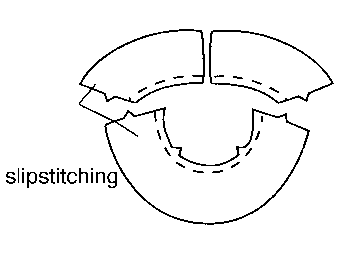 |
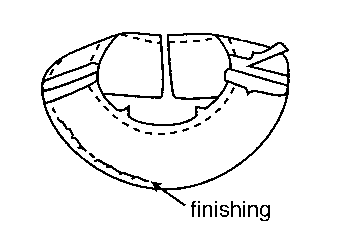 |
|---|---|
| Figure 1 | Figure 2 |
Place the right sides of the facing and the garment together. Match seams and notches and stitch the facing to the garment with the facing side up (Figure 3). Grade the seam allowance by trimming the facing narrower than the garment seam allowance to prevent bulk (Figure 4). Clip the seam allowances on the inward curve every 1/2 in. Stay-stitch the neckline and armholes of the facing pieces and the garment. Press the seam allowance toward the facing and understitch (Figure 5).
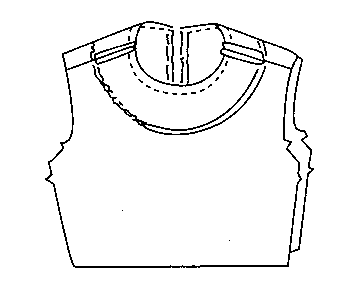 |
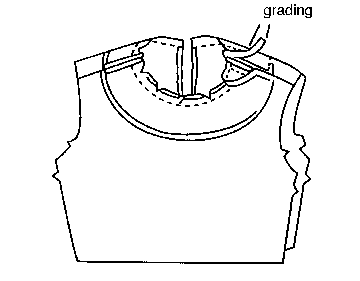 |
|---|---|
| Figure 3 | Figure 4 |
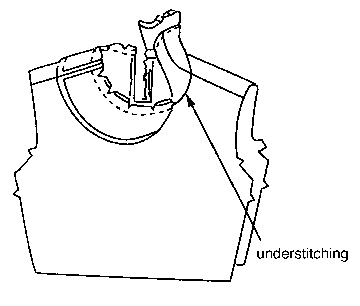 |
|---|
| Figure 5 |
Some patterns use a combination piece, which includes a facing for the neckline and the armholes as one piece. In this case, the facing should only be stitched at the side seams rather than the shoulder seams (Figure 6). Place the right sides of the facing and garment together, matching the notches. Stitch the facing to the bodice at the neckline and armholes. Stitch with the facing side up. Do not stitch the shoulder seams (Figure 7). Grade and clip seams. Understitch where possible. Turn the facing to the inside and press the seams. Stitch the garment shoulder seam together (Figure 8).
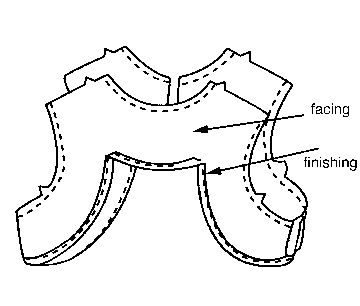 |
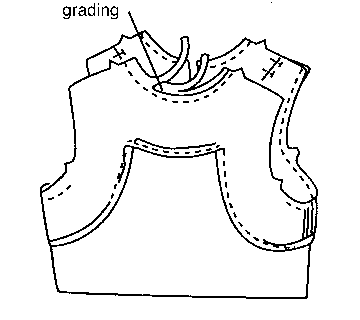 |
|---|---|
| Figure 6 | Figure 7 |
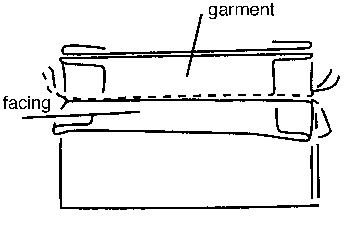 |
|---|
| Figure 8 |
Extended Facings
An extended facing is cut as an extension of the garment and then folded back along the edge it finishes (Figure 9). Extended facings are often used on garments with front or back openings cut on a straight line. The neckline of an extended facing is a shaped facing and should be applied using the same techniques as other facings (Figure 10).
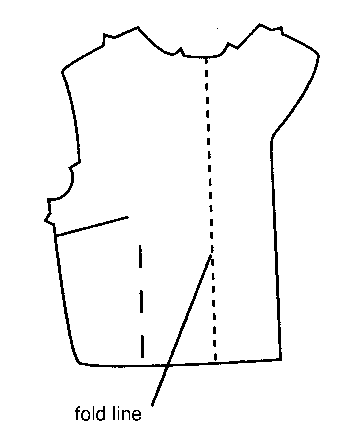 |
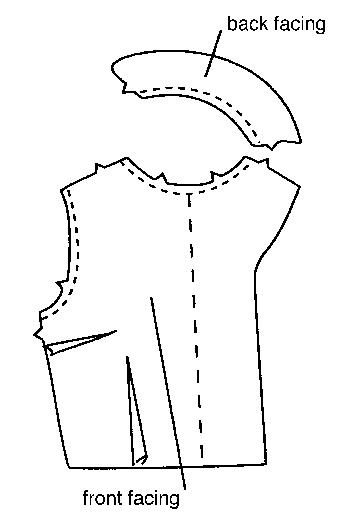 |
|---|---|
| Figure 9 | Figure 10 |
Fusible interfacings may be applied to the facing side of an extended facing. The interfacing is applied to the body of the garment. If you are using a sew-in interfacing, catch-stitch the interfacing in place prior to any stitching (whereas a fusible interfacing must be fused in place before proceeding).
Prepare the facing by stitching the pieces together, pressing, and finishing the edge (Figure 11). Grade the neckline seam allowance by trimming the facing narrower than the garment seam allowance (Figure 12). Clip the seam allowance on the inward curve every 1/2 in. Turn the facing to the inside and press. Understitch the seam allowance where possible. Fold the facing along the fold line to match right sides together. Stitch along the neckline seam. Reinforce stitch near the folded edge (Figure 13).
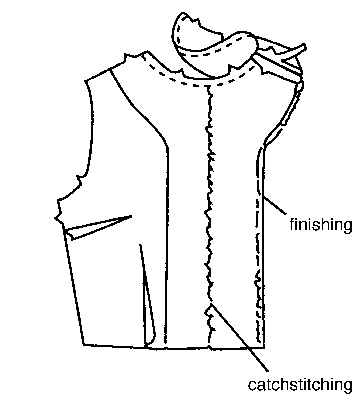 |
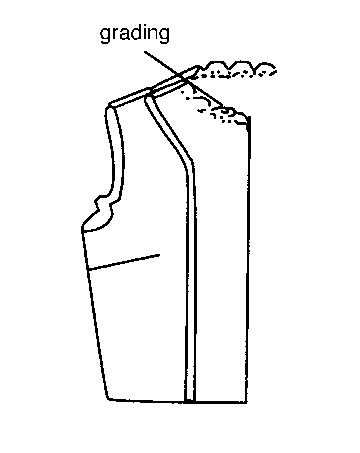 |
|---|---|
| Figure 11 |
Figure 12 |
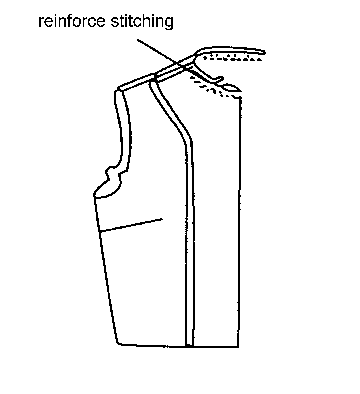 |
|---|
| Figure 13 |
Bias Facings
A bias facing is a narrow strip of lightweight fabric cut on the bias so that it can be shaped to conform to the curve it will finish. Bias facings are often used on sheer fabrics to eliminate a wide facing that may show through. Bias facings are also used on children's garments. A bias strip of lining fabric can eliminate heavy shaped facings on bulky fabrics. A bias facing should be about 1/2 in. wide when finished.
Cut the bias strip twice as wide as the desired finished width plus the width of two seam allowances (Figure 14). The length should be the length of the edge at the seamline plus 2 in. (Figure 15). Fold the strip in half lengthwise with wrong sides together. Press with a steam iron to shape the strip the same as the edge it will fit (Figure 16). Keep the raw edges even. Baste the strip to the garment, keeping the edges even (Figure 17). Then stitch the strip to the garment, easing the bias strip on the inward curves and stretching on the outward curves. Grade the seam allowances by trimming the facing narrower than the garment seam allowance (Figure 18). Clip the seam allowance on the inward curve every 1/2 in.
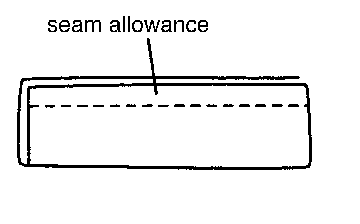 |
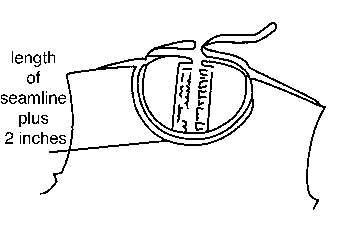 |
|---|---|
| Figure 14 | Figure 15 |
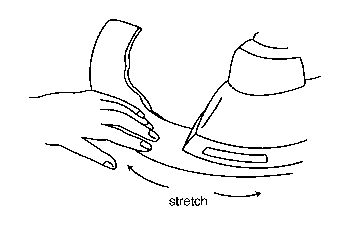 |
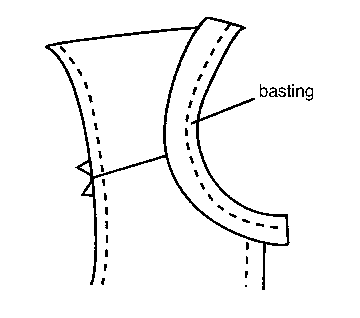 |
|---|---|
| Figure 16 | Figure 17 |
 |
|---|
| Figure 18 |
Turn the facing to the inside and understitch. This will let the seamline roll slightly to the inside. Trim ends and turn under 1/4 in. at the garment opening. Slipstitch the edge of the facing to the inside of the garment (Figure 19).
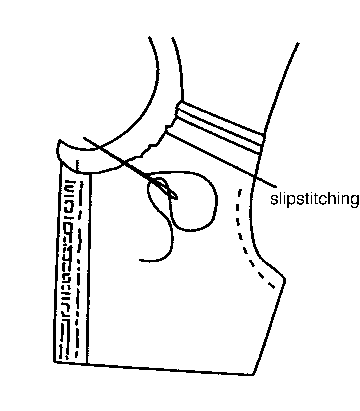 |
|---|
| Figure 19 |
Tips For Applying Facings
- Both shaped and bias facings can be cut from a fabric lighter in weight than the garment to reduce bulk.
- If you have to alter the pattern, be sure to alter facings and interfacings to match.
- Interface a facing that will have buttonholes in it.
- Make facings smooth and flat by clipping inward curves and notching outward curves.
- Understitch shaped and extended facings to keep them from rolling to the outside of the garment.
- Finish outer edges of facings. Generally, the same finish that is applied to seams can be used to finish facing edges. Use the least bulky seam finish that will prevent raveling.
- Tack facings only at seams, such as the underarm seam or side seam. Do not hand stitch the outer facing edge to the garment all the way around; this gives garments a puckered and unprofessional look.
- Finish neckline facings over zippers as illustrated in Figure 20. Then sew a hook and eye or flying snap to hold edges closed.
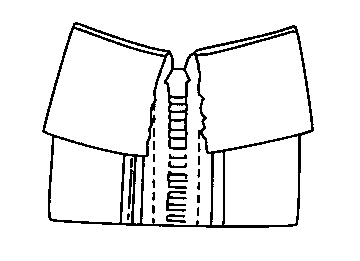 |
|---|
| Figure 20 |
Original author: Susan Wright, former Extension specialist, from a publication by Lenda Jo Anderson, Alabama Cooperative Extension Service.
To find more resources for your business, home, or family, visit the College of Agricultural, Consumer and Environmental Sciences on the World Wide Web at pubs.nmsu.edu
Contents of publications may be freely reproduced for educational purposes. All other rights reserved. For permission to use publications for other purposes, contact pubs@nmsu.edu or the authors listed on the publication.
New Mexico State University is an equal opportunity/affirmative action employer and educator. NMSU and the U.S. Department of Agriculture cooperating.
Revised and electronically distributed October 2010, Las Cruces, NM.


